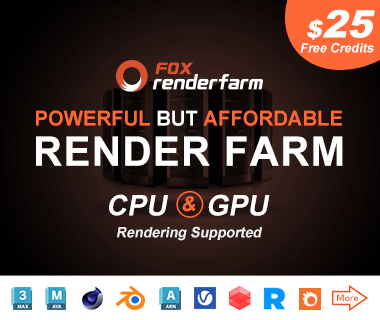¿Cómo Elegir el Mejor Ordenador para Modelado y Renderizado? Guía Definitiva
Para los diseñadores profesionales y los escultores, el modelado y el renderizado 3D son componentes esenciales. Con software especializado, pueden crear representaciones 3D de objetos o escenas, desde formas básicas hasta estructuras complejas. Además, el renderizado transforma estos modelos en imágenes de aspecto realista. Juntos, estos procesos son fundamentales para industrias como el desarrollo de videojuegos y el diseño de productos.
Este renderizado altamente realista se realiza mediante un ordenador de renderizado o un sistema similar de alto rendimiento. Permite a las empresas visualizar el producto para ayudarles a tomar decisiones de diseño cruciales. En cualquier caso, siga leyendo esta guía y aprenda el proceso de construcción del mejor PC para las necesidades de modelado y renderizado 3D.

Parte 1. ¿Se Necesita un Buen Ordenador para el Modelado 3D?
Para iniciar un debate, es necesario comprender por qué es importante construir un buen ordenador para el renderizado 3D. Dado que el modelado es una tarea exigente, depende en gran medida de las capacidades del ordenador. Requiere un hardware potente para manejar cálculos complejos y renderizar imágenes de alta calidad de manera eficiente. El uso de un ordenador estándar puede hacer que los usuarios tengan dificultades con tareas intensivas como la manipulación de modelos detallados.
Los usuarios deben optar por un ordenador de alto rendimiento con mucha memoria RAM y una GPU potente. Además, elegir un buen ordenador garantiza que el sistema pueda manejar la multitarea y el renderizado en tiempo real sin retrasos ni fallos. Un ordenador optimizado para el modelado 3D puede proporcionar la velocidad necesaria para que los profesionales trabajen sin problemas. Invertir en un buen ordenador diseñado para el modelado 3D puede marcar una diferencia significativa en la calidad y la eficiencia de su trabajo.

Parte 2. Comprar o Montar su Propio PC: ¿Cuál es la Mejor Opción?
Continuando, compararemos si es mejor comprar o montar su propio PC. Aunque comprar el mejor ordenador para modelado 3D ofrece comodidad, armar su propio PC permite personalizarlo. Ambas opciones tienen sus pros y sus contras, dependiendo de su experiencia y presupuesto.
| Aspecto | Comprar un PC | Montar un PC |
| Precio | Costoso debido a los costos de marca y ensamblaje. | Asequible, ya que el usuario puede adquirir los componentes de forma estratégica. |
| Rendimiento | Fiable y optimizado para uso general. | Rendimiento personalizable para adaptarse a los requisitos exactos. |
| Tiempo y Esfuerzo Invertidos | Listo para usar y fácil de configurar. | Requiere mucho tiempo, ya que se necesitan habilidades técnicas para montarlo. |
| Flexibilidad | Es limitado, ya que está vinculado a los componentes. | Altamente flexible, ya que los componentes se pueden actualizar. |
| Asistencia Técnica y Garantía | Incluye garantía completa del sistema con asistencia al cliente. | Garantías individuales para cada componente sin asistencia al cliente. |
| Habilidad | No se requieren conocimientos técnicos. | Requiere conocimientos de montaje de hardware. |
Parte 3. ¿Qué Especificaciones en la PC Necesito para Modelado y Renderizado?
Además de lo anterior, veamos las especificaciones de la PC que se necesitan para el modelado y el renderizado. Seleccionar las especificaciones adecuadas para una computadora de modelado 3D y renderizado es fundamental para garantizar un rendimiento fluido y flujos de trabajo eficientes. A continuación, compararemos las especificaciones mínimas y recomendadas para construir una buena computadora para esta tarea.
Procesador
El procesador es el corazón de su PC y, cuando se trata de renderización 3D, desempeña un papel crucial en el procesamiento de cálculos complejos. Un procesador más rápido permite un manejo más fluido de tareas complejas como simulaciones, cálculos y multihilo.
| Componente | Requisitos Mínimos | Requisitos Recomendados |
| Procesador | Procesador de cuatro núcleos, 3,0 GHz o superior. | Intel Core i7/i9 o AMD Ryzen 9, 4,0 GHz o superior |
Tarjeta Gráfica
Además del procesador, la tarjeta gráfica es fundamental para renderizar imágenes y texturas de alta calidad en modelos 3D. También mejora la capacidad de manejar archivos más grandes y detalles visuales más complejos, lo que mejora la experiencia general de renderizado.
| Componente | Requisitos Mínimos | Requisitos Recomendados |
| Tarjeta Gráfica | NVIDIA GTX 1660 o equivalente con 4 GB de VRAM | NVIDIA RTX 3080/3090 o AMD Radeon RX 6900 XT con 8-16 GB de VRAM |
RAM
Con una mayor capacidad de RAM, su mejor ordenador para renderizado 3D puede funcionar más rápido y procesar escenas más complejas simultáneamente. Esto reduce el retraso y los fallos del sistema, lo que permite una experiencia de renderizado fluida.
| Componente | Requisitos Mínimos | Requisitos Recomendados |
| RAM | 16GB DDR4 | 32GB DDR4 |
Almacenamiento
Las Unidades de Estado Sólido (SSD) ofrecen velocidades de lectura/escritura más rápidas, lo que ayuda a cargar archivos grandes más rápidamente y reduce los tiempos de espera. La combinación de SSD y HDD garantiza tanto velocidad como espacio suficiente para todos sus datos.
| Componente | Requisitos Mínimos | Requisitos Recomendados |
| Almacenamiento | SSD PNY de 120 GB y HDD de 1 TB | MX500 SSD de 250 GB y HDD de 2 TB |
Monitor
Lo más importante es que debe tener un buen monitor, ya que aquí verá el resultado final de su trabajo. Por lo tanto, asegúrese de tener una pantalla de alta resolución que mejore la precisión al detallar sus diseños. Una pantalla IPS con precisión de color es fundamental para el renderizado 3D profesional, ya que garantiza que los colores que vea sean precisos.
| Componente | Requisitos Mínimos | Requisitos Recomendados |
| Monitor | 24 pulgadas Full HD (1920 x 1080), 60 Hz | 27 pulgadas, 4K (3840 x 2160), 144 Hz, precisión de color con panel IPS. |
Invertir en las especificaciones recomendadas garantiza que su ordenador de renderizado esté bien equipado para gestionar proyectos grandes, renderizados complejos y multitarea. Elegir las especificaciones adecuadas no solo mejora el rendimiento, sino que también garantiza que su configuración esté preparada para las exigencias cambiantes del software y los flujos de trabajo.
Consejo para el Renderizado 3D: Una Mejor Manera de Mejorar el Renderizado
¿Usted desea ahorrar dinero en hardware y mejorar la eficiencia de su renderizado? Al utilizar un servicio de granja de renderizado, puede mejorar sus capacidades de renderizado sin verse limitado por el rendimiento de los dispositivos locales. Las granjas de renderizado basadas en la nube, como Fox Renderfarm, un servicio de renderizado en la nube líder en el mundo, ofrecen soluciones rápidas y escalables que le ayudarán a abordar proyectos 3D complejos.

Además, su capacidad para poner en marcha rápidamente miles de nodos de renderizado aporta una escalabilidad y una velocidad sin igual. Le permite centrarse en su trabajo creativo sin preocuparse por las limitaciones de su hardware. Las siguientes características le ayudarán a comprender mejor cómo Fox Renderfarm mejora el flujo de trabajo de renderizado 3D:
- Compatibilidad Multiplataforma: Disponible en Windows, Mac o Linux, el servicio de renderizado en la nube Fox Renderfarm se integra perfectamente en su flujo de trabajo actual. Por lo tanto, destaca como una solución adaptable a diferentes sistemas operativos y elimina los problemas de compatibilidad.
- Automatización Simplificada con API: El servicio ofrece compatibilidad con API, lo que permite una integración perfecta en su proceso de producción. Esta automatización elimina la necesidad de entradas manuales, lo que garantiza un flujo de trabajo más eficiente y optimizado.
- Almacenamiento Rápido para Archivos Grandes: El uso de almacenamiento SSD ayuda a Fox Renderfarm a evitar cuellos de botella en el rendimiento, lo que garantiza que los archivos 3D complejos se procesen sin retrasos para acelerar todo el proceso de renderizado.
- Almacenamiento Rápido para Archivos Grandes: el uso de almacenamiento SSD ayuda a Fox Renderfarm a evitar cuellos de botella en el rendimiento, lo que garantiza que los archivos 3D complejos se procesen sin retrasos para acelerar todo el proceso de renderizado.
- Atención al Cliente 24/7: un equipo dedicado está disponible las 24 horas del día para proporcionar asistencia oportuna, resolver problemas y garantizar que sus tareas de renderizado avancen sin contratiempos, manteniendo un flujo de trabajo constante.
- Integración con Herramientas 3D Populares: Fox Renderfarm es compatible con varios programas de diseño 3D líderes para garantizar que sus herramientas favoritas se puedan incorporar fácilmente al proceso de renderización, maximizando la productividad.
Conclusión
En conclusión, este artículo profundiza en la importancia de contar con un ordenador potente para el modelado y el renderizado 3D, lo que pone de relieve el papel del hardware en la obtención de resultados. Los servicios de renderizado en la nube, como Fox Renderfarm, ofrecen una solución excelente para aquellos que buscan aumentar la velocidad de renderizado y ahorrar en costes de hardware. Al aprovechar estos servicios, los artistas 3D pueden eludir las limitaciones de los dispositivos locales y centrarse más en la creatividad.
Además, optimizar tanto el hardware como el enfoque de renderizado mejorará su experiencia de modelado 3D. Seguir las especificaciones recomendadas anteriormente puede reducir significativamente los tiempos de renderizado y mejorar la productividad general.
Recommended reading
Top 9 Best And Free Blender Render Farms of 2025
2024-12-30
What is Jibaro? Reveal the Story and Techniques Behind the Production of Jibaro "Love, Death & Robots"
2025-11-03
Top 10 Free And Best Cloud Rendering Services in 2025
2025-03-03
8 Best & Free 3d Rendering Software for Architects & Designers
2025-09-04
Top 8 After Effects Render Farm Recommended of 2025
2025-02-10
Easy Cel Shading Tutorial for Cartoon in Blender Within 2 Minutes
2025-02-10
Shocked! The Secret Behind Using 3D to Make 2D Animation was Revealed!
2025-02-10
How to Render High-quality Images in Blender
2024-12-04
Partners
Previous: Creación de Humanos en Blender: Una Guía Definitiva
Next: ¿Cómo Crear el Mejor Sombreador de Agua en Blender?
Interested






